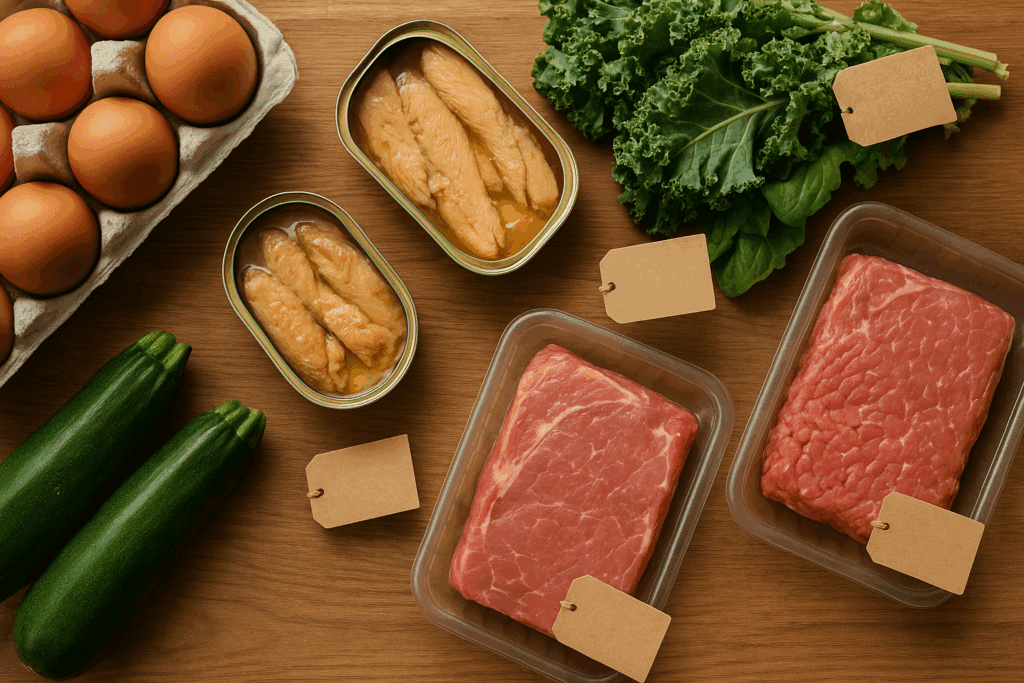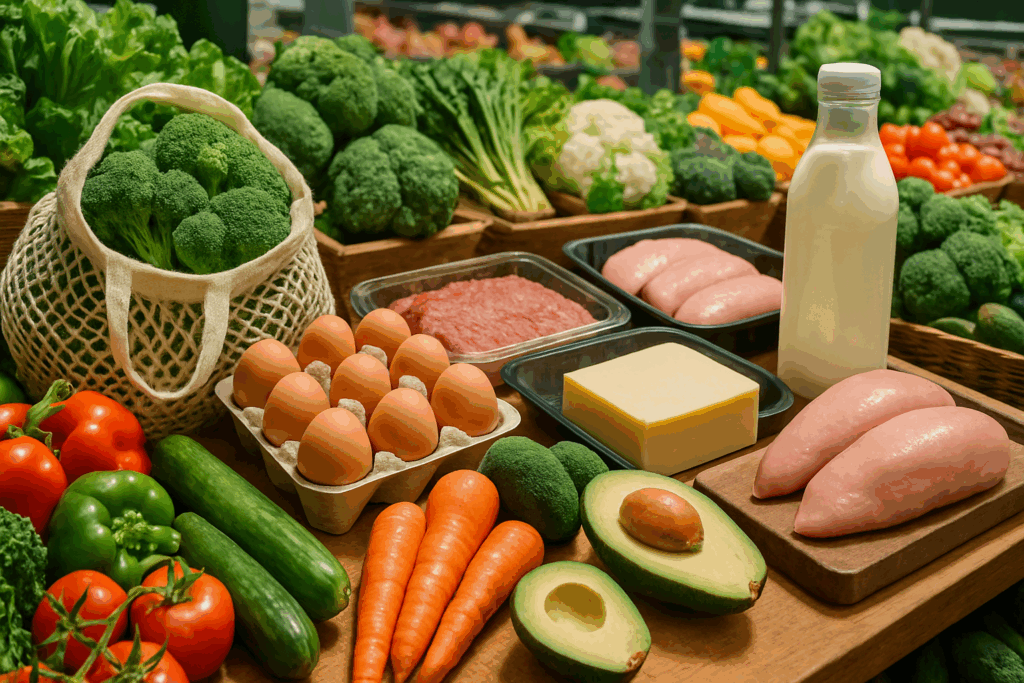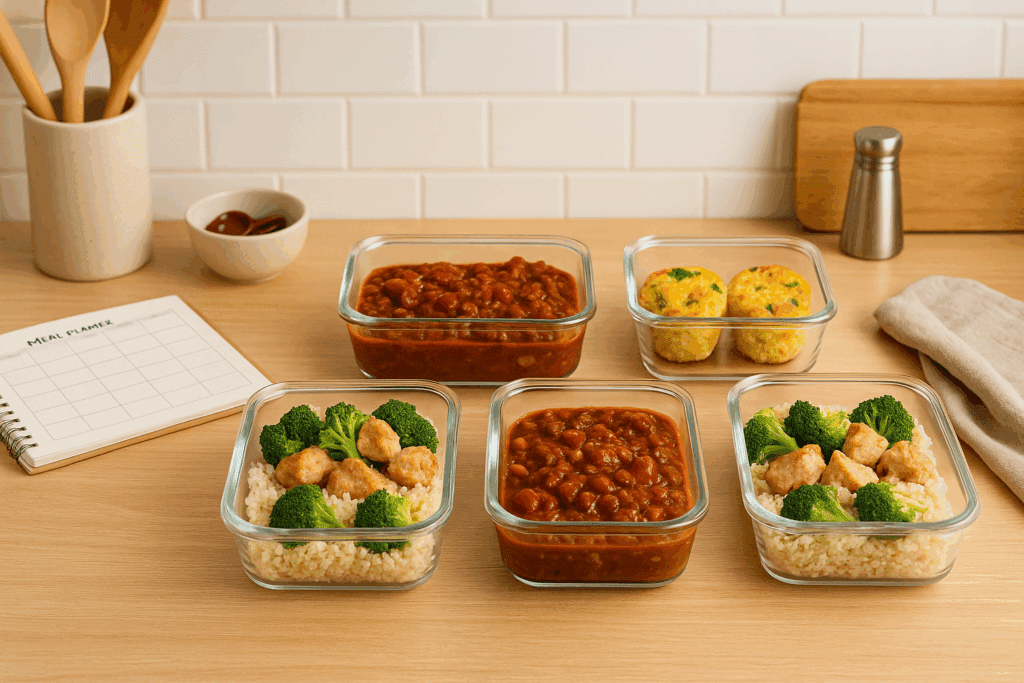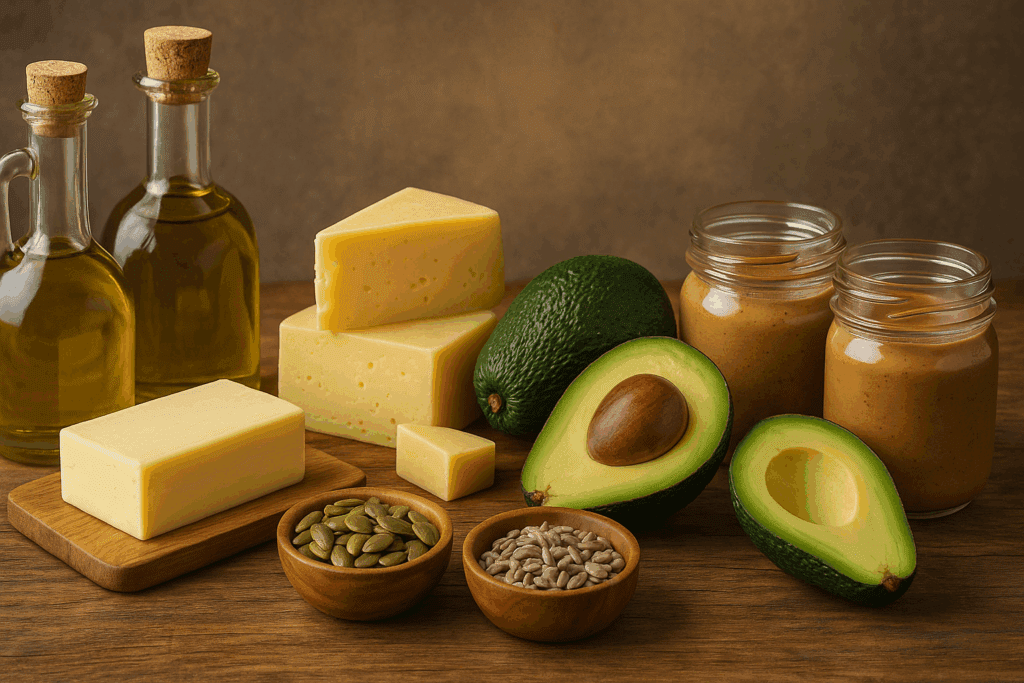Adopting a ketogenic lifestyle doesn’t mean surrendering your financial stability. While the keto diet is often associated with premium cuts of meat, pricey oils, and specialty products marketed at health food stores, the reality is that this way of eating can be tailored to suit nearly any budget. In fact, with the right strategies, a keto approach can be both cost-effective and nutritionally sound, offering lasting health benefits without breaking the bank. Understanding how to build affordable keto meals using cheap keto foods starts with rethinking what truly matters: nutrient density, satiety, and simplicity.
You may also like: Is the Keto Diet Safe or Dangerous? What Experts Say About the Risks, Benefits, and Basics of the Ketogenic Diet

Understanding the Foundation of the Keto Diet on a Budget
At its core, the ketogenic diet revolves around reducing carbohydrate intake and increasing fat consumption to shift the body into a state of ketosis. In ketosis, the body uses fat rather than glucose as its primary energy source. While many envision keto meals filled with expensive grass-fed beef, imported cheeses, and gourmet oils, the essential metabolic principle does not require extravagance. What matters more than product branding is macronutrient composition. Thus, the framework for cheap keto meals begins by focusing on foods that are high in healthy fats and moderate in protein, with minimal carbs, without assuming those foods must carry premium price tags.
Eggs, for example, are one of the most versatile and nutrient-rich cheap keto foods. At just a few cents per egg, they deliver high-quality protein, fats, and essential vitamins. Cabbage, spinach, and zucchini are budget-friendly vegetables that are low in carbohydrates and can be used in countless ways. Ground meats, especially when bought in bulk, offer protein at a lower cost than premium cuts. These basics form the backbone of many affordable keto meals that are both satisfying and metabolically effective.

How to Strategically Shop for Cheap Keto Foods
Budget-conscious keto shopping begins with a plan. Before heading to the grocery store, it’s essential to understand which foods offer the most nutritional bang for your buck. Start by evaluating your weekly meals and identifying which ingredients can be reused across multiple recipes. For instance, buying a whole chicken can supply protein for several meals while also providing bones for a nutrient-rich bone broth. Canned fish like sardines and mackerel are not only high in omega-3s and healthy fats but are also significantly cheaper than fresh fillets.
Shopping the perimeter of the grocery store typically yields the best keto-friendly and budget-friendly options. This area usually includes fresh produce, meat, and dairy—the core components of most keto meal plans. Avoid prepackaged keto-labeled snacks and substitutes, which are often overpriced and nutritionally inferior. When looking to add variety to your diet, frozen vegetables are a fantastic option. They are often just as nutritious as fresh ones and can be stored for months, reducing waste and saving money over time. By adopting a bulk shopping strategy and prioritizing nutrient-dense staples, creating affordable keto meals becomes an achievable goal for anyone.

Meal Prepping for Maximum Savings and Nutritional Efficiency
Meal preparation is a cornerstone of affordable and successful ketogenic eating. Preparing meals in advance not only saves time but significantly reduces impulsive spending on takeout or convenience foods that are often not keto-compliant. It also encourages portion control, which can reduce food waste and further lower your grocery bill. Cheap keto meals often begin with batch-cooked ingredients, such as ground beef, cauliflower rice, or boiled eggs, that can be repurposed throughout the week.
By cooking once and eating multiple times, you ensure consistency in your macronutrient intake while controlling for cost. A large pot of keto chili made with ground turkey, diced tomatoes, and inexpensive vegetables like bell peppers and zucchini can serve as lunch or dinner for several days. Similarly, egg muffins baked with spinach and cheese can be frozen and reheated for quick breakfasts. These tactics not only simplify your week but also support your long-term adherence to a ketogenic lifestyle without financial strain. In this way, the intersection of affordability and nutritional consistency is maintained.

Navigating Protein Sources Without Overspending
One of the most common misconceptions about keto is that it requires high quantities of premium meats. While protein is essential, it does not need to be sourced from the most expensive items in the meat case. Instead, opt for cost-effective proteins that still offer quality amino acid profiles. Ground beef, chicken thighs, pork shoulder, and canned tuna are all excellent choices that align with the goals of the keto diet without exceeding your budget. These options can be enhanced with herbs, spices, and low-cost marinades to add variety and depth to your meals.
Organ meats like liver and heart are often overlooked, but they are among the most nutrient-dense and cheap keto foods available. They offer rich sources of iron, vitamin A, and essential B vitamins. If taste is a concern, these can be incorporated into ground meat dishes to balance flavor and texture. Additionally, plant-based keto-friendly proteins like tofu and tempeh offer inexpensive alternatives that are especially useful for those looking to diversify their meal plans without relying solely on animal products. Protein does not have to be a budget buster if you know where to look and how to prepare it creatively.

Incorporating Healthy Fats Without High Costs
Fat is the cornerstone of the ketogenic diet, and sourcing healthy, affordable fat sources is essential for both metabolic balance and budget maintenance. Olive oil, often found in bulk at warehouse stores or through online retailers, is a staple in most kitchens and offers a heart-healthy fat option. Butter, ghee, and lard are traditional fats that are widely available, inexpensive, and ideal for cooking. Avocados, while sometimes considered pricey, can be cost-effective when purchased in bags or during seasonal sales.
Cheese is another versatile ingredient that brings flavor, fat, and satiety to affordable keto meals. Look for block cheese rather than pre-shredded varieties, as the latter often comes with unnecessary additives and a higher price per ounce. Nut butters, when purchased in bulk or store-brand varieties, offer both convenience and nutritional value. Seeds like sunflower and pumpkin are excellent fat sources and can be added to salads, yogurts, or eaten as snacks. By focusing on unprocessed, whole fat sources, you support both your health goals and your financial boundaries.
Maximizing the Nutritional Value of Vegetables on a Budget
Contrary to the misconception that keto discourages vegetable consumption, low-carb vegetables are not only encouraged but critical for fiber intake, micronutrient diversity, and digestive health. Fortunately, many of these vegetables are among the most affordable items in the produce aisle. Cabbage, kale, spinach, zucchini, cauliflower, and cucumbers are just a few examples of cheap keto foods that can be rotated to keep meals interesting without straining your budget.
The key is to buy in-season and local whenever possible. Farmers’ markets, discount grocers, and even community-supported agriculture (CSA) programs can provide fresh produce at reduced costs. In addition, frozen options often retain most of their nutritional value and come with the added benefit of long shelf life. Including a wide range of vegetables in your affordable keto meals ensures that you are not only meeting your macro goals but also supporting immune health, inflammation control, and long-term wellness.
Avoiding Common Pitfalls in Budget Keto Planning
When trying to save money on keto, it can be tempting to gravitate toward highly processed “keto-friendly” snacks and pre-made meals. These items may fit within your macronutrient limits but are often laden with artificial ingredients, low in actual nutrients, and inflated in price. In contrast, a whole-foods-based approach to cheap keto meals emphasizes quality without requiring quantity.
Another trap is failing to diversify ingredients, which can lead to boredom, dietary burnout, and ultimately, diet abandonment. While budget constraints are real, they do not have to equate to monotony. Rotating between different protein sources, vegetables, and spices keeps meals exciting. Finally, poor portion planning can lead to waste—not just of food but also of money. Buying large quantities of perishable items without a plan to use them can quickly backfire. Smart, intentional meal planning is what transforms low-cost keto from a struggle into a sustainable lifestyle.
Creating Satisfying and Affordable Keto Meals for the Whole Family
One of the benefits of following a ketogenic diet on a budget is the simplicity it encourages. Dishes like casseroles, stir-fries, soups, and salads are naturally adaptable and inexpensive. A cauliflower and cheese bake, seasoned with herbs and topped with shredded chicken, can feed several people at minimal cost. Egg-based dishes such as frittatas or quiches (without crusts) are perfect for using leftovers and can be eaten at any time of day.
For families, making cheap keto meals can be a collaborative effort. Cooking together teaches children the value of nutrition and budgeting, while also fostering appreciation for whole foods. By involving the entire household in planning and preparation, you also increase the chances of long-term adherence. Serving meals that meet everyone’s needs without requiring multiple separate preparations is a win-win for time, money, and nutrition.
Why Affordable Keto Eating Is a Long-Term Investment in Health
While some may view cheap keto meals as a compromise, in reality, they reflect a more sustainable and mindful way of eating. By focusing on nutrient-dense, minimally processed, and strategically sourced ingredients, you’re not only cutting costs but also investing in better metabolic health. Research has shown that ketogenic diets can support weight management, improve insulin sensitivity, and reduce inflammation—all of which are foundational to disease prevention and wellness.
When approached with care and intentionality, affordable keto meals do not sacrifice quality or flavor. In fact, many people find that removing the frills and focusing on basic, wholesome ingredients allows them to better understand their body’s nutritional needs. This approach reduces dependency on food marketing, encourages cooking skills, and promotes food literacy—critical tools in maintaining both health and financial wellness.
Frequently Asked Questions (FAQ): Smart Eating on a Budget with Affordable Keto Meals
1. What are some lesser-known cheap keto foods that offer high nutritional value?
While staples like eggs and ground meat are well-known, there are several overlooked cheap keto foods that deliver excellent nutrition without the premium price tag. For instance, canned cod liver is incredibly rich in vitamin D and omega-3 fatty acids and is often more affordable than fresh fish. Kohlrabi, a low-carb cruciferous vegetable, is inexpensive and provides a crunchy, versatile addition to any keto dish. Chicken hearts and gizzards, often sold at discount prices, offer protein and essential micronutrients like iron and B12. Incorporating these less conventional items into your affordable keto meals can boost both nutritional density and variety, helping you maintain dietary interest without added expense.
2. How can I save money on keto without sacrificing food quality?
Choosing affordable keto meals doesn’t mean compromising on quality. One of the most effective strategies is buying whole foods in bulk from local co-ops or wholesale stores, particularly for nuts, seeds, oils, and frozen vegetables. Additionally, opting for bone-in, skin-on meats not only lowers cost but enhances flavor and nutritional profile. Another tip is to reduce reliance on keto-branded products; these often come with a markup and offer little added value over natural, whole cheap keto foods. Finally, developing a seasonal meal rotation using local produce ensures fresher ingredients and lower prices throughout the year.
3. Can intermittent fasting help me stretch my budget while following keto?
Yes, integrating intermittent fasting into a ketogenic lifestyle is a practical way to reduce your food spending while maintaining ketosis. By condensing your eating window, you’re naturally consuming fewer meals, which in turn decreases your grocery expenses. This approach aligns well with affordable keto meals, as it reduces the frequency of cooking and food prep. Moreover, fasting can enhance metabolic efficiency, which may make your body more responsive to cheap keto foods that are nutrient-dense rather than calorie-heavy. Just ensure that your eating periods include balanced meals with sufficient fat and protein to maintain energy and nutrient levels.
4. How do cultural cuisines inspire affordable keto meals?
Exploring global cuisines is a creative way to diversify cheap keto meals while sticking to a budget. For instance, traditional Mediterranean diets use olive oil, sardines, olives, and eggplant—all of which align beautifully with keto principles and are often low-cost. Indian cuisine offers inspiration through dishes that feature low-carb vegetables like cauliflower and spices that add flavor without expense. Latin American dishes utilizing pork, avocado, and cabbage are equally fitting for affordable keto meals. By borrowing these culinary ideas, you can introduce bold flavors and new textures without turning to costly specialty items.
5. What cooking techniques can make cheap keto foods taste gourmet?
Elevating inexpensive ingredients into satisfying meals is more about technique than cost. Roasting low-cost vegetables like cabbage or zucchini can bring out natural sweetness and depth of flavor. Slow-cooking tough cuts of meat like pork shoulder turns them into tender, savory staples perfect for cheap keto meals. Pan-searing meats in seasoned butter or finishing a dish with a splash of vinegar can dramatically improve taste without adding cost. Even a basic scrambled egg dish can feel gourmet when prepared with aromatic herbs and a touch of cream. Investing in a few kitchen skills can help transform budget-friendly ingredients into restaurant-quality meals.
6. Are there psychological benefits to preparing affordable keto meals at home?
Absolutely. Cooking your own meals fosters a sense of control and accomplishment that contributes to mental well-being. When you commit to crafting affordable keto meals, you engage in mindful eating, which can improve your relationship with food and your body. There is also reduced stress from financial strain, since cheap keto foods help stretch your grocery dollars further. In addition, preparing meals can serve as a creative outlet and even a family bonding activity, enhancing social and emotional wellness. These intangible benefits make the effort of home cooking a valuable component of a holistic health strategy.
7. How can I make affordable keto meals kid-friendly?
Making cheap keto meals appealing to children requires creativity but is entirely feasible. For example, turning cauliflower into cheesy “tots” or baking almond flour-based chicken tenders can replicate familiar flavors in keto-friendly ways. Smoothies made with spinach, avocado, and unsweetened cocoa can disguise nutrient-dense ingredients in a kid-approved format. It also helps to involve kids in the cooking process, allowing them to choose which cheap keto foods to include in their lunchboxes or snacks. Gradually incorporating these meals into the family routine can foster better long-term eating habits for everyone involved.
8. What are some smart storage tips for preserving cheap keto foods?
Proper storage is essential to avoid waste and extend the life of your groceries, especially when working with affordable keto meals. Investing in airtight containers and labeling leftovers with dates can prevent spoilage and unnecessary spending. Freeze pre-portioned servings of soups or casseroles so they can be easily thawed for future meals. Certain cheap keto foods like cabbage, eggs, and hard cheeses have long shelf lives, especially when stored in cooler zones of your fridge. For bulk items like nuts and seeds, keeping them in a dark, cool pantry helps preserve their fats and prevents rancidity.
9. Can I maintain a keto lifestyle while traveling on a budget?
Yes, with preparation, you can sustain a keto lifestyle while traveling, even on a tight budget. Pack shelf-stable cheap keto foods like beef jerky, canned sardines, and nut butter to avoid overpriced airport or convenience store snacks. Booking accommodations with a kitchenette allows you to prepare affordable keto meals rather than relying on restaurant options. When dining out, choosing bunless burgers, grilled meats, and side salads keeps you within your dietary goals. Planning ahead and packing light but strategic food items ensures you remain in ketosis without derailing your budget.
10. What are future trends in affordable keto eating I should be aware of?
Emerging trends suggest that affordable keto meals will become even more accessible through community-based food initiatives and innovations in food tech. For instance, local urban farms and cooperative gardens are increasingly offering cheap keto foods like leafy greens and herbs at reduced prices. Additionally, technology-driven platforms are now offering recipe planning services that tailor affordable keto meals based on regional pricing and store availability. There is also growing interest in sustainability, with zero-waste cooking and nose-to-tail consumption gaining popularity among keto eaters. As the keto movement matures, accessibility and affordability are likely to improve for everyone.
Closing Thoughts on Cheap Keto Foods and Lasting Wellness
There is something deeply empowering about mastering the art of nourishing your body without draining your wallet. By embracing a resourceful mindset, learning to identify cheap keto foods that deliver both value and nutrition, and crafting affordable keto meals that truly satisfy, individuals can reclaim control over both their health and their spending. It is not necessary to splurge on specialty items to succeed on a ketogenic diet. Rather, success lies in consistency, planning, and a willingness to experiment with whole, affordable ingredients.
Cheap keto meals are not only feasible but often more fulfilling because they shift focus from marketing-driven consumption to intentional, values-based nourishment. With a little creativity and a strong foundation in nutritional knowledge, eating keto on a budget becomes less about restriction and more about empowerment. It is here, in the balance between frugality and nourishment, that the most sustainable wellness journeys begin.
Further Reading:
57 Easy Keto Dinner Recipes Everyone In The Family Will Love
10 Keto Diet Meals You Can Make for $5 or Less
15+ Cheap Keto Meals For Dinner


